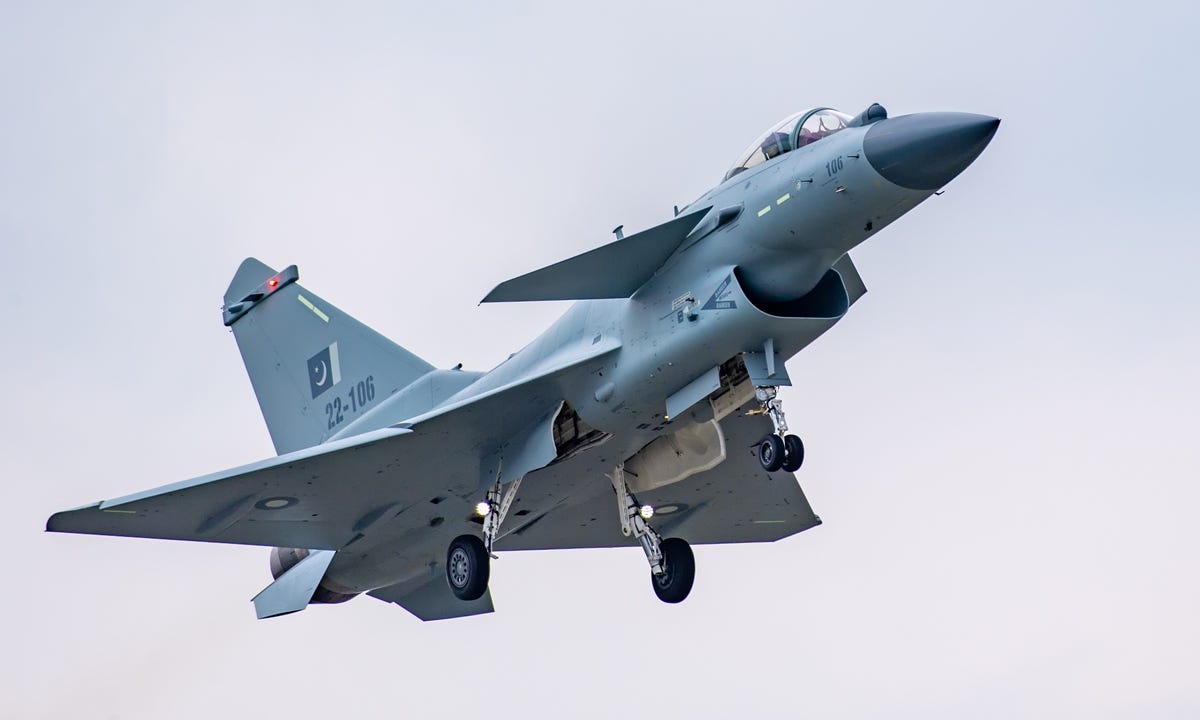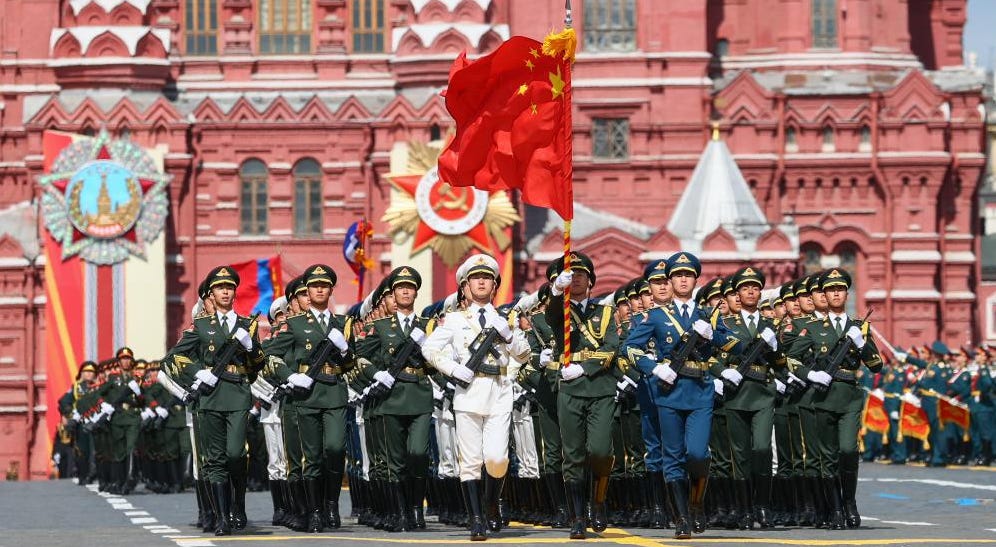China's good wars, in trade and south Asian skies
Trade war update, Chinese jets shoot down India's planes, Xi in Moscow, Latin America comes to Beijing, mixed economic signals, new tech
This is The China Week, a succinct roundup and analysis of what happened in the People’s Republic in the last seven days.
Please take out a paid subscription to get the whole newsletter!
—Jeremy Goldkorn
Trump blinks harder
China and U.S. agree on trade war truce

China and the U.S. agreed to a temporary truce in the trade war during meetings in Geneva, Switzerland on May 10 and 11. Vice Premier and economic czar He Lifeng 何立峰, and Vice Minister of Commerce Li Chenggang 李成钢 led the Chinese side, while the U.S. was represented by Treasury Secretary Scott Bessent and U.S. Trade Representative Jamieson Greer.
The details of the agreement were released on May 12. In summary:
U.S. tariffs on most Chinese imports will fall to from 145% to 30%
Chinese tariffs on most U.S. imports will fall from 125% to 10%
China has undertaken to scrap some non-tariff countermeasures, such as restrictions on the export of critical minerals to the U.S.
After the text of agreement was released, the U.S. unilaterally announced that it would cut tariffs on low-value (de minimis) parcels from China such as those sent by ecommerce companies Shein and Temu to 54% from 120%.
A strangely good deal for China
What to make of all of this?
The Economist says: “America has given China a strangely good tariff deal.”
“America has chickened out,” according to various Chinese social media posts.
“Awesome!” state affiliated commentator Hu Xijin 胡锡进 posted to social media (in Chinese): “The ‘principle of equality’ has achieved a milestone victory in the China-U.S. negotiations!”
Sinocism newsletter author Bill Bishop says “Both sides looked to have blinked but I think the U.S. side blinked harder.”
Veteran China business journalist Dexter Roberts says that the White House’s characterization of the agreement as “historic win” is, in “the immortal words of former Chinese leader Jiang Zemin… ‘too simple, sometimes naive.’”
Research firm Trivium calls the “tariff rollback…a clear vindication of Beijing’s calculated, proportional approach to responding to the Trump administration’s trade actions,” but notes that “even with the pause, global supply chain volatility is the new normal.”
The Financial Times quotes Craig Singleton of the Foundation for Defense of Democracies, a think-tank in Washington as saying it “was ‘striking’ how quickly the deal had emerged, suggesting that ‘both sides were more economically boxed in than they let on.’”
The end of decoupling?
One of the consistent messages from the U.S. side, as expressed by Treasury Secretary Scott Bessent, is a rejection of an idea that has been very popular in Washington D.C. for several years: economic decoupling with China.
Over the last week, Bessent has said: “We don't want to decouple — what we want is fair trade," and also that the U.S. does “not want a generalized decoupling from China.” After the weekend meetings, Bessent told a news conference: “We concluded that we have a shared interest…The consensus from both delegations is that neither side wanted a decoupling.”
Links and sources
Joint statement on China-U.S. economic and trade meeting in Geneva; views from Beijing / Beijing Scroll
Full transcript of China's press conference on China-U.S. economic and trade talks / Geopolitechs
Trump slashes ‘de minimis’ tariffs on small shipments from China / Wall Street Journal
Pakistan-India conflict
Chinese jets tested in combat

Pakistan (China’s “iron brother”) and India (which has a much testier relationship with its northern neighbor) engaged in a short war last week.
Skirmishes began after a terrorist attack that killed 26 civilians in the Indian-administered Jammu and Kashmir on April 22, 2025 and spiraled into a conflict that involved fighter jets, missiles, and drones, before a ceasefire was announced on May 10.
“Chinese media, analysts and commentators have amplified the Pakistani narrative on the conflict,” notes the scholar Manoj Kewalramani. On Chinese social media, nationalists praised the performance of Chinese weapons’ systems, particularly Chinese-made jets which brought down at least two and perhaps as many as five Indian fighter aircraft of French and Russian manufacture.
“Many likened the moment to another ‘DeepSeek Moment’—a reference to China’s growing confidence in its domestically developed technologies,” writes Eric Olander.
Vlad and Xi have quality time
Xi Jinping spends four days in Moscow

Xi Jinping paid a four-day state visit to Russia, where he attended the “celebrations marking the 80th anniversary of the victory in the Soviet Union's Great Patriotic War.”
The visit should have put paid to any hopes in the U.S. of a “reverse Kissinger” that would isolate China, as Moscow and Beijing released various statements and a joint declaration that emphasized the depth of their partnership, and Putin’s growing dependence on Xi.
Compared with a joint declaration issued last year, this year’s contains “more direct criticism of the U.S.,” notes Fred Gao: “The statement no longer uses vague terms like ‘certain countries’ but directly refers to ‘resolutely responding to the U.S. “dual containment” policy against China and Russia,’ and clearly opposes ‘attempts by the United States and its allies to advance NATO's eastward expansion into the Asia-Pacific.’”
‘Facing blackmail without fear’
China has a picnic in America’s backyard
CELAC is not a disease of the digestive tract, it is the China-Community of Latin American and Caribbean States Forum.
Today, May 13, Beijing hosted the “fourth ministerial meeting” of CELAC, attended by Xi Jinping, president Gustavo Petro of Colombia, president Luiz Inácio Lula da Silva of Brazil, president Gabriel Boric of Chile, and representatives from more than 20 Latin American and Caribbean countries.
Chinese state media has publicized two outcomes: One is a declaration to reaffirm a commitment to peace, development and cooperation, the other is a plan for promised cooperation in technology, trade, investment, infrastructure and, of course, Belt and Road stuff.
There is, naturally, rhetoric directed against the U.S.:
Keep reading with a 7-day free trial
Subscribe to The China Week to keep reading this post and get 7 days of free access to the full post archives.

